Numerical and Experimental Modal Analysis of a Gyroid Inconel 718 Structure for Stiffness Specification in the Design of Load-Bearing Components
Abstract
:1. Introduction
2. State of the Art
3. Methods and Materials
3.1. Materials
3.2. Stiffness of a Machine
3.3. Modal Analysis
3.3.1. Numerical Analysis
3.3.2. Experimental Analysis
4. Results and Discussion
5. Conclusions
- In this paper, numerical and experimental modal analyses of porous specimens made of Inconel 718 alloy are presented to define the stiffness of load-bearing components. The authors pointed out the possibilities of implementing triply periodic minimal surfaces porous structures together with the specification of natural frequencies and modes of lightweight load-bearing components of machines, which can be considered a novelty.
- The analysis specified the first four natural frequencies ranging from 10 to 16 kHz. The results revealed that the first natural frequency corresponds to the first torsional frequency about the Z axis, the second to the first flexural mode in the XZ plane, the third to the first bending mode in the YZ plane, and the fourth to the first torsional mode about the X axis.
- The maximum relative error of 6.53% between both approaches in the range of quantified natural frequencies has been identified and can be considered acceptable for the given conditions. The differences that arose during the experimental modal analysis were caused by errors in the geometry of the realistic production effects and probably by careless removal from the platform. Smaller deviations in the results can also be expected due to the sensor gluing procedure.
- Although modal analysis of solid components has been used in many studies, the investigation of modal properties of the complex TPMS structures is still rare since the preparation of geometry and the FE model mesh has proved challenging.
- Taking into account porosity as an advantage, the stiffness and damping properties of the porous model with the gyroid structure can be consequently increased using, e.g., a liquid or other independent material to fill the cavities.
Author Contributions
Funding
Institutional Review Board Statement
Informed Consent Statement
Data Availability Statement
Acknowledgments
Conflicts of Interest
References
- Vazdirvanidis, A.; Pressas, I.; Papadopoulou, S.; Toulfatzis, A.; Rikos, A.; Katsivarda, M.; Pantazopoulos, G. Examination of Formability Properties of 6xxx Alloy Extruded Profiles for the Automotive Industry. In Proceedings of the TMS 2019 Annual Meeting & Exhibition, San Antonio, TX, USA, 10–14 March 2019. [Google Scholar] [CrossRef]
- Grbović, A.; Kastratović, G.; Božić, I.; Obradović, A.; Sedmak, A.; Sedmak, S. Experimental and numerical evaluation of fracture characteristics of composite material used in the aircraft engine cover manufacturing. Eng. Fail. Anal. 2022, 137, 106286. [Google Scholar] [CrossRef]
- Zolotarevich, V.P.; Salienko, A.E.; Frumen, A.I.; Yugov, N.V. Numerical and Experimental Research of Natural Frequencies and Mode Shapes for Runner of Francis Turbine. Procedia Struct. Integr. 2017, 6, 224–227. [Google Scholar] [CrossRef]
- Šmeringaiová, A.; Vojtko, I.; Monková, K. Experimentelle Analyse der Dynamik von Zahnradgetrieben—Teil 1. Tech. Mess. 2015, 82, 57–64. [Google Scholar] [CrossRef]
- Papadopoulou, S.; Pressas, I.; Vazdirvanidis, A.; Pantazopoulos, G. Fatigue failure analysis of roll steel pins from a chain assembly: Fracture mechanism and numerical modeling. Eng. Fail. Anal. 2019, 101, 320–328. [Google Scholar] [CrossRef]
- Milovanović, N.; Sedmak, A.; Arsic, M.; Sedmak, S.; Božić, I. Structural integrity and life assessment of rotating equipment. Eng. Fail. Anal. 2020, 113, 104561. [Google Scholar] [CrossRef]
- Grzesik, W.; Niesłony, P.; Habrat, W.; Sieniawski, J.; Laskowski, P. Investigation of tool wear in the turning of Inconel 718 superalloy in terms of process performance and productivity enhancement. Tribol. Int. 2018, 118, 337–346. [Google Scholar] [CrossRef]
- Yong, C.K.; Gibbons, G.J.; Wong, C.C.; West, G. A Critical Review of the Material Characteristics of Additive Manufactured IN718 for High-Temperature Application. Metals 2020, 10, 1576. [Google Scholar] [CrossRef]
- Deng, D.; Peng, R.L.; Brodin, H.; Moverare, J. Microstructure and mechanical properties of Inconel 718 produced by selective laser melting: Sample orientation dependence and effects of post heat treatments. Mater. Sci. Eng. A 2018, 713, 294–306. [Google Scholar] [CrossRef]
- Psyllaki, P.P.; Pantazopoulos, G.; Lefakis, H. Metallurgical evaluation of creep-failed superheater tubes. Eng. Fail. Anal. 2009, 16, 1420–1431. [Google Scholar] [CrossRef]
- Wang, Z.; Zhao, Z.; Liu, B.; Huo, P.; Bai, P. Compression properties of porous Inconel 718 alloy formed by selective laser melting. Adv. Compos. Hybrid Mater. 2021, 4, 1309–1321. [Google Scholar] [CrossRef]
- Zhao, Z.; Xu, X.; Wang, Q.; Bai, P.; Du, W.; Zhang, L.; Wang, W. Microstructure and properties of periodic porous Inconel 718 alloy prepared by selective laser melting. Adv. Compos. Hybrid Mater. 2021, 4, 332–338. [Google Scholar] [CrossRef]
- Wang, X.; Wang, C.; Zhou, X.; Wang, D.; Zhang, M.; Gao, Y.; Wang, L.; Zhang, P. Evaluating Lattice Mechanical Properties for Lightweight Heat-Resistant Load-Bearing Structure Design. Materials 2020, 13, 4786. [Google Scholar] [CrossRef]
- Kladovasilakis, N.; Tsongas, K.; Tzetzis, D. Finite Element Analysis of Orthopedic Hip Implant with Functionally Graded Bioinspired Lattice Structures. Biomimetics 2020, 5, 44. [Google Scholar] [CrossRef] [PubMed]
- Yang, C.; Li, Q.; Wang, Y. Compressive properties of cuttlebone-like lattice (CLL) materials with functionally graded density. Eur. J. Mech. A/Solids 2021, 87, 104215. [Google Scholar] [CrossRef]
- Monkova, K.; Monka, P.P.; Pantazopoulos, G.A.; Toulfatzis, A.I.; Šmeringaiová, A.; Török, J.; Papadopoulou, S. Effect of Crosshead Speed and Volume Ratio on Compressive Mechanical Properties of Mono- and Double-Gyroid Structures Made of Inconel 718. Materials 2023, 16, 4973. [Google Scholar] [CrossRef] [PubMed]
- Monkova, K.; Pantazopoulos, G.; Toulfatzis, A.; Papadopoulou, S.; Monka, P.P.; Vanca, J. Tensile fracture analysis of 3D printed Inconel 718. Procedia Struct. Integr. 2023, 46, 30–34. [Google Scholar] [CrossRef]
- Riva, L.; Ginestra, P.S.; Ceretti, E. Mechanical characterization and properties of laser-based powder bed–fused lattice structures: A review. Int. J. Adv. Manuf. Technol. 2021, 113, 649–671. [Google Scholar] [CrossRef]
- Beghini, M.; Grossi, T.; Macoretta, G.; Monelli, B.D.; Senegaglia, I.; del Turco, P.; Fardelli, A.; Morante, F. Tuning Modal Be-haviour of Additively Manufactured Lattice Structures. J. Eng. Gas Turbines Power 2024, 146, 071008. [Google Scholar] [CrossRef]
- Mishra, A.K.; Kumar, A. Performance of asymmetric octet lattice structures under compressive and bending loads. Eng. Fail. Anal. 2023, 154, 107669. [Google Scholar] [CrossRef]
- Magarò, P.; Alaimo, G.; Carraturo, M.; Sgambitterra, E.; Maletta, C. A novel methodology for the prediction of the stress–strain response of laser powder bed fusion lattice structure based on a multi-scale approach. Mater. Sci. Eng. A 2023, 863, 144526. [Google Scholar] [CrossRef]
- Pantazopoulos, G.; Vazdirvanidis, A. Metallurgical investigation on fatigue failure of stainless steel chain in a continuous casting machine. Eng. Fail. Anal. 2009, 16, 1623–1630. [Google Scholar] [CrossRef]
- Niutta, C.B.; Paolino, D.; Tridello, A. Additively manufactured lattice structures: An innovative defect-based design methodology against crash impact. Eng. Fail. Anal. 2023, 152, 107436. [Google Scholar] [CrossRef]
- Abueidda, D.W.; Elhebeary, M.; Shiang, C.-S.; Pang, S.; Abu Al-Rub, R.K.; Jasiuk, I.M. Mechanical properties of 3D printed polymeric Gyroid cellular structures: Experimental and finite element study. Mater. Des. 2019, 165, 107597. [Google Scholar] [CrossRef]
- Yánez, A.; Cuadrado, A.; Martel, O.; Afonso, H.; Monopoli, D. Gyroid porous titanium structures: A versatile solution to be used as scaffolds in bone defect reconstruction. Mater. Des. 2018, 140, 21–29. [Google Scholar] [CrossRef]
- Mahbod, M.; Asgari, M. Elastic and plastic characterization of a new developed additively manufactured functionally graded porous lattice structure: Analytical and numerical models. Int. J. Mech. Sci. 2019, 155, 248–266. [Google Scholar] [CrossRef]
- Karmiris-Obratanski, P.; Thangaraj, M.; Leszczyńska-Madej, B.; Markopoulos, A.P. Advanced Machining Technology for Modern Engineering Materials. Materials 2024, 17, 2064. [Google Scholar] [CrossRef]
- Li, D.; Liao, W.; Dai, N.; Dong, G.; Tang, Y.; Xie, Y.M. Optimal design and modeling of gyroid-based functionally graded cellular structures for additive manufacturing. Comput. Des. 2018, 104, 87–99. [Google Scholar] [CrossRef]
- Madariaga, A.; Garay, A.; Esnaola, J.A.; Arrazola, P.J.; Linaza, A. Effect of surface integrity generated by machining on isothermal low cycle fatigue performance of Inconel 718. Eng. Fail. Anal. 2022, 137, 106422. [Google Scholar] [CrossRef]
- Ji, H.; Gupta, M.K.; Song, Q.; Cai, W.; Zheng, T.; Zhao, Y.; Liu, Z.; Pimenov, D.Y. Microstructure and machinability evaluation in micro milling of selective laser melted Inconel 718 alloy. J. Mater. Res. Technol. 2021, 14, 348–362. [Google Scholar] [CrossRef]
- Saberi, E.; Nakhodchi, S.; Dargahi, A.; Nikbin, K. Predicting stress and creep life in Inconel 718 blade-disk attachments. Eng. Fail. Anal. 2020, 108, 104226. [Google Scholar] [CrossRef]
- AMS 5664E; Nickel Alloy, Corrosion and Heat Resistant, Bars, Forgings, and Rings 52.5Ni-19Cr-3.0Mo-5.1Cb-0.90Ti-0.50Al-18Fe Consumable Electrode or Vacuum Induction melted 1950 °F (1066 °C) Solution Heat Treated, Precipitation Hardenable. SAE International: Warrendale, PA, USA, 2006.
- EOS NickelAlloy IN 718, 2014, Material Data Sheet, EOS GmbH-Electro Optical Systems, TMS, WEIL/05. 2014. Available online: https://www.eos.info/03_system-related-assets/material-related-contents/metal-materials-and-examples/metal-material-datasheet/nickelalloy-inconel/material_datasheet_eos_nickelalloy_in718_m290_premium_en_web.pdf (accessed on 11 June 2024).
- Mehdi, K.; Rigal, J.-F.; Play, D. Dynamic Behavior of a Thin-Walled Cylindrical Workpiece During the Turning Process, Part 1: Cutting Process Simulation. J. Manuf. Sci. Eng. 2002, 124, 562–568. [Google Scholar] [CrossRef]
- Demec, P. Prouction Technique—Basis of Design; TUKE Slovakia: Košice, Slovakia, 2013; ISBN 978-80-553-1615-4. [Google Scholar]
- Liu, L.; Thangaraj, M.; Karmiris-Obratański, P.; Zhou, Y.; Annamalai, R.; Machnik, R.; Elsheikh, A.; Markopoulos, A.P. Optimization of Wire EDM Process Parameters on Cutting Inconel 718 Alloy with Zinc-Diffused Coating Brass Wire Electrode Using Taguchi-DEAR Technique. Coatings 2022, 12, 1612. [Google Scholar] [CrossRef]
- Sippel, J.P.; Kerscher, E. Influence of fracture toughness and defect size on vibration characteristics and resulting stress amplitude of AISI 52100 and AISI 4140 during ultrasonic fatigue testing. Procedia Struct. Integr. 2023, 47, 608–616. [Google Scholar] [CrossRef]
- Simsek, U.; Arslan, T.; Kavas, B.; Gayir, C.E.; Sendur, P. Parametric studies on vibration characteristics of triply periodic minimum surface sandwich lattice structures. Int. J. Adv. Manuf. Technol. 2021, 115, 675–690. [Google Scholar] [CrossRef]
- Inman, D.J. Engineering Vibration, 2nd ed.; Prentice Hall PTR: Hoboken, NJ, USA, 2000; ISBN 9780137261420. [Google Scholar]
- Grega, R.; Krajňák, J.; Žuľová, L.; Fedorko, G.; Molnár, V. Failure analysis of driveshaft of truck body caused by vibrations. Eng. Fail. Anal. 2017, 79, 208–215. [Google Scholar] [CrossRef]
- Mironovs, D.; Ručevskis, S.; Dzelzītis, K. Prospects of Structural Damage Identification Using Modal Analysis and Anomaly Detection. Procedia Struct. Integr. 2022, 37, 410–416. [Google Scholar] [CrossRef]
- Archenti, A.; Nicolescu, M.; Casterman, G.; Hjelm, S. A New Method for Circular Testing of Machine Tools Under Loaded Condition. Procedia CIRP 2012, 1, 575–580. [Google Scholar] [CrossRef]
- Huang, D.T.-Y.; Lee, J.-J. On obtaining machine tool stiffness by CAE techniques. Int. J. Mach. Tools Manuf. 2001, 41, 1149–1163. [Google Scholar] [CrossRef]
- Stejskal, T.; Svetlík, J.; Dovica, M.; Demeč, P.; Kráľ, J. Measurement of Static Stiffness after Motion on a Three-Axis CNC Milling Table. Appl. Sci. 2018, 8, 15. [Google Scholar] [CrossRef]
- Wang, L.; Hou, P.; Wang, S.; Wang, C.; Yan, X.; Wang, X. Study on the effect of rolling mill dynamic stiffness on coupled vibration of hydraulic machine. J. Vibroeng. 2024, 26, 455–468. [Google Scholar] [CrossRef]
- Donmez, M.; Hahn, M.; Soons, J. A Novel Cooling System to Reduce Thermally-Induced Errors of Machine Tools. CIRP Ann. 2007, 56, 521–524. [Google Scholar] [CrossRef]
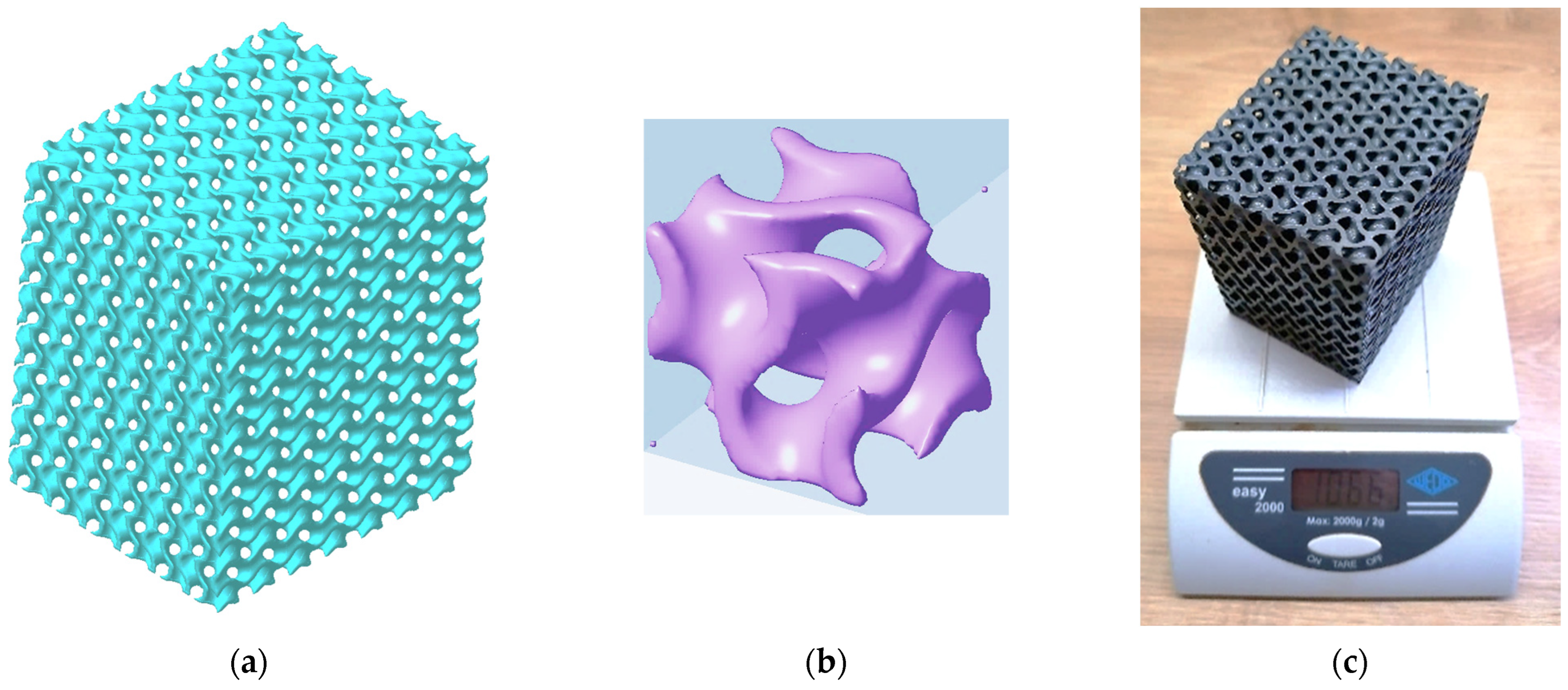
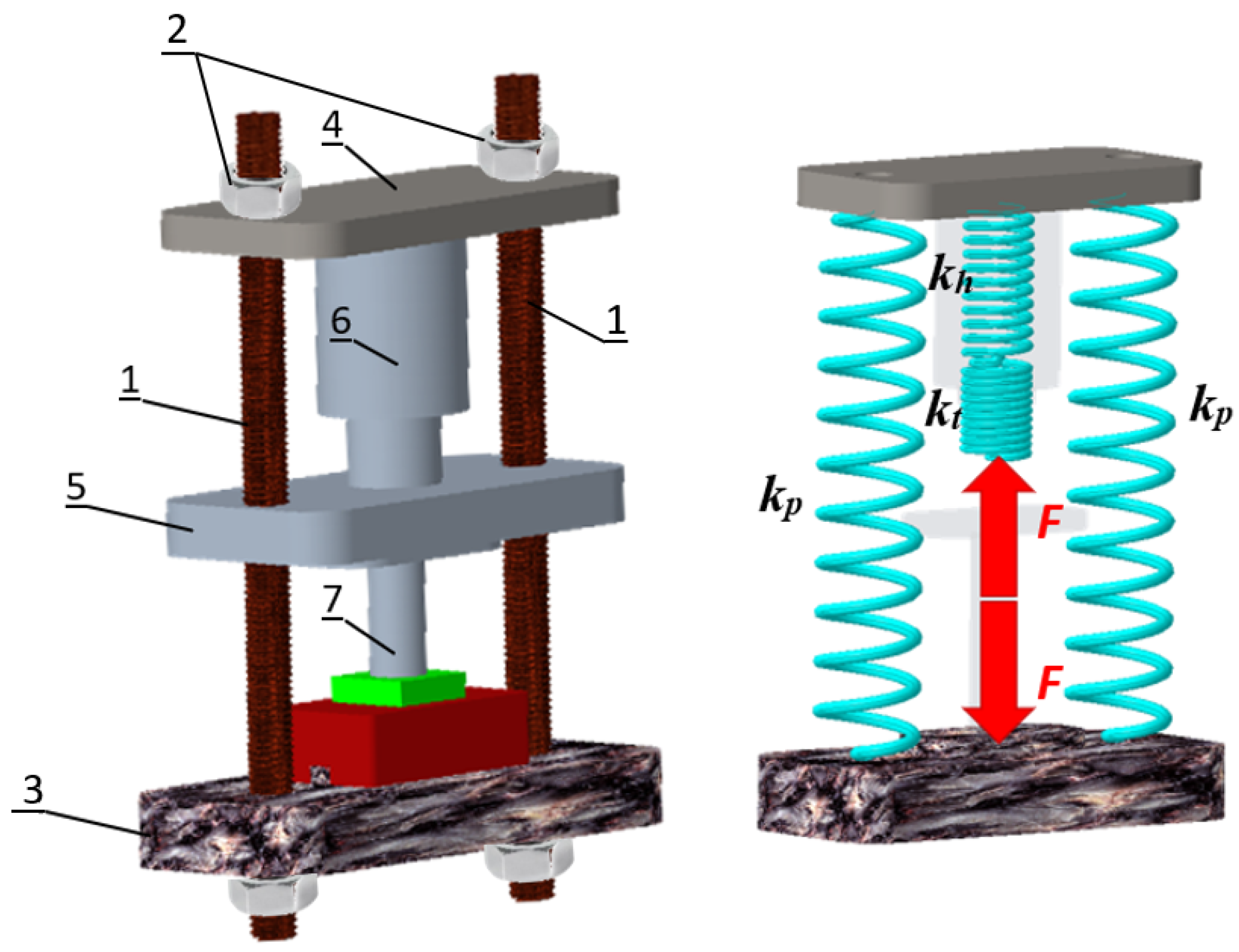
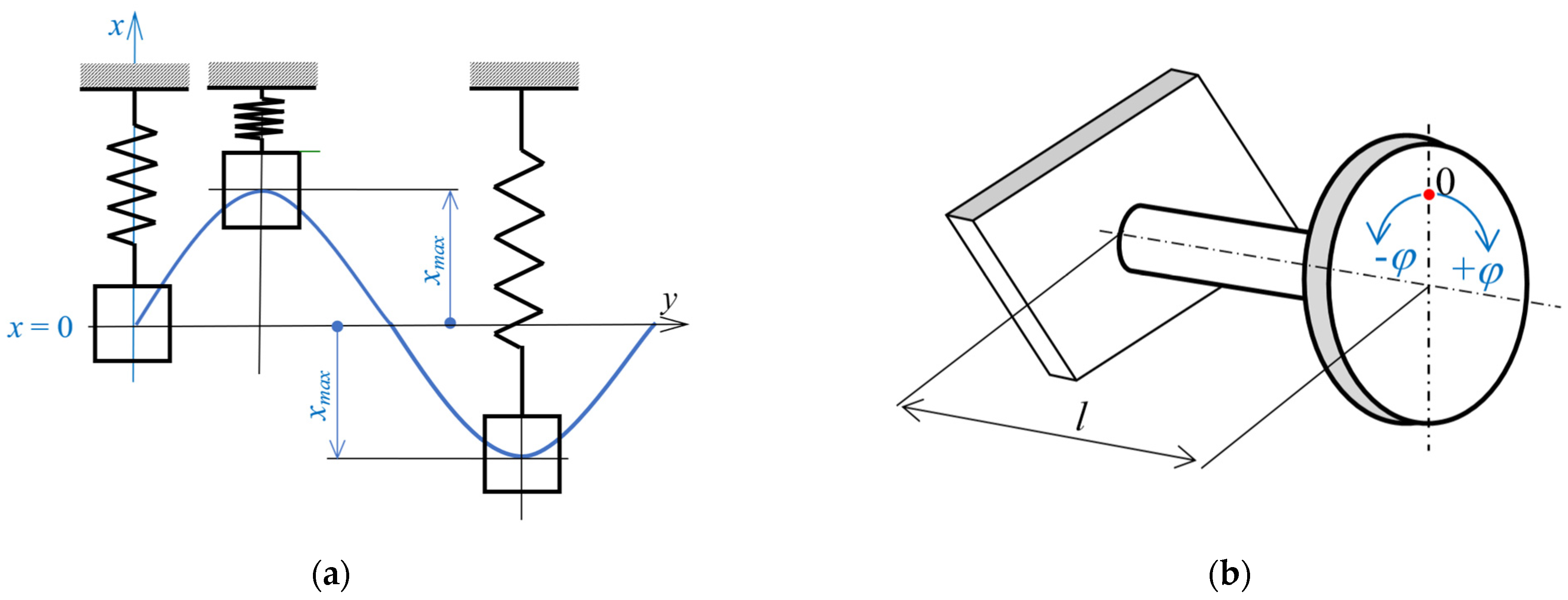


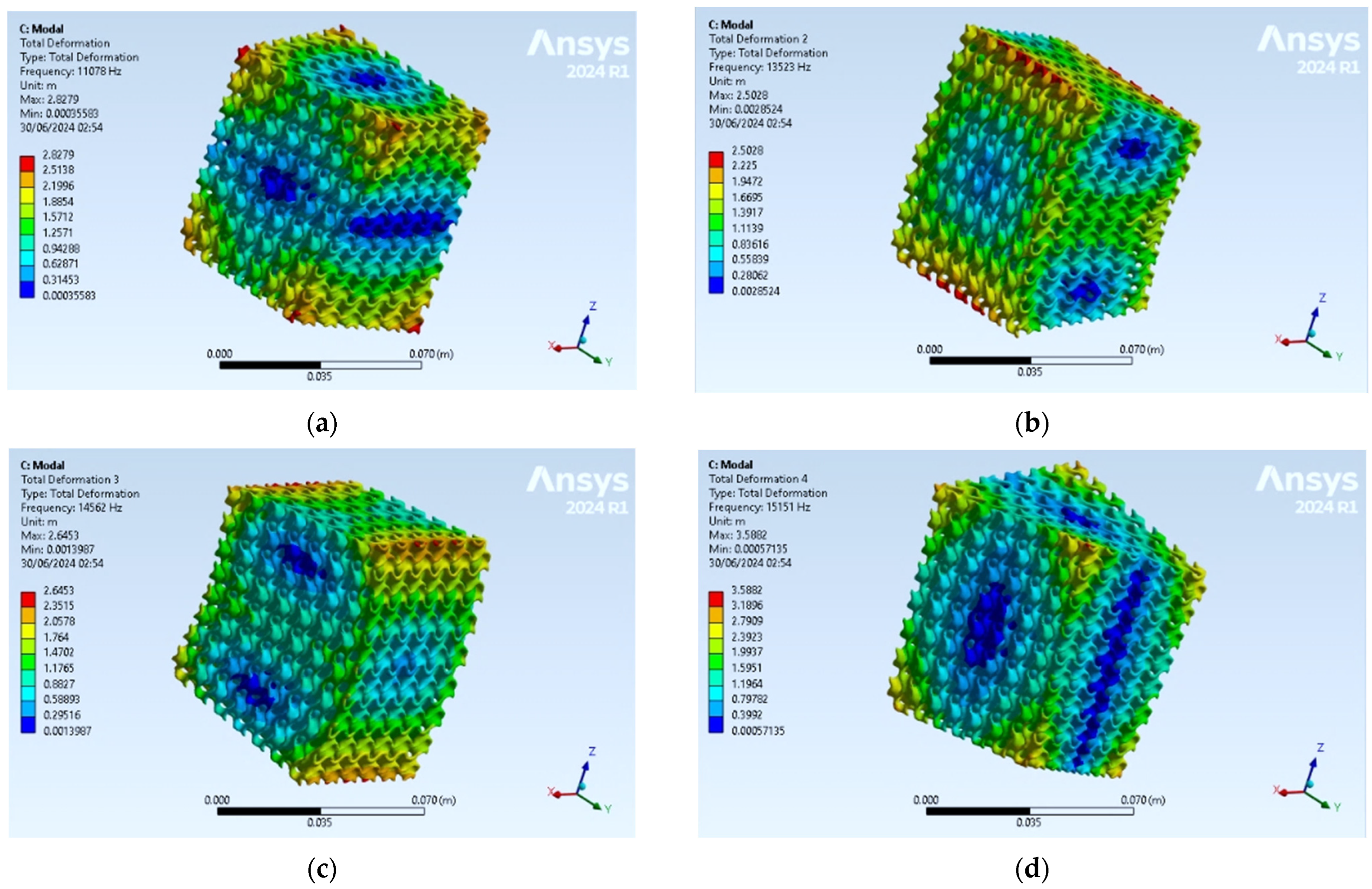

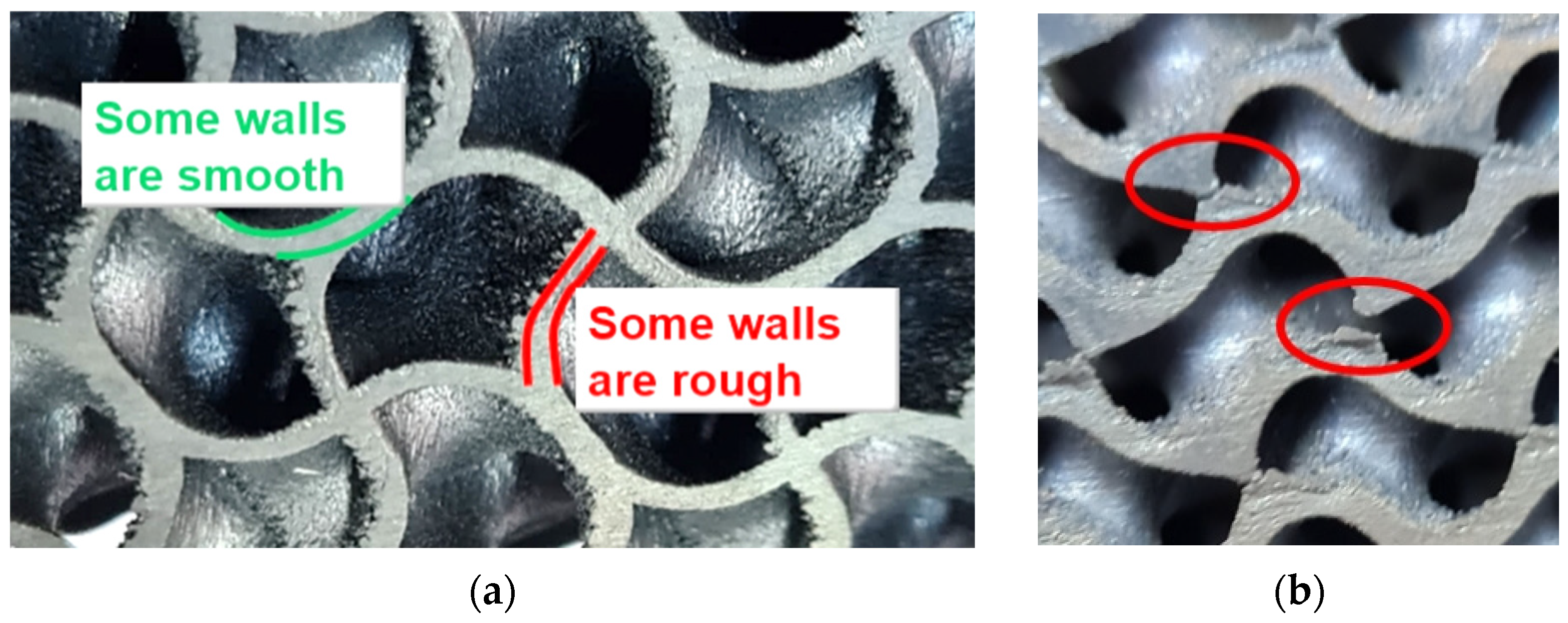
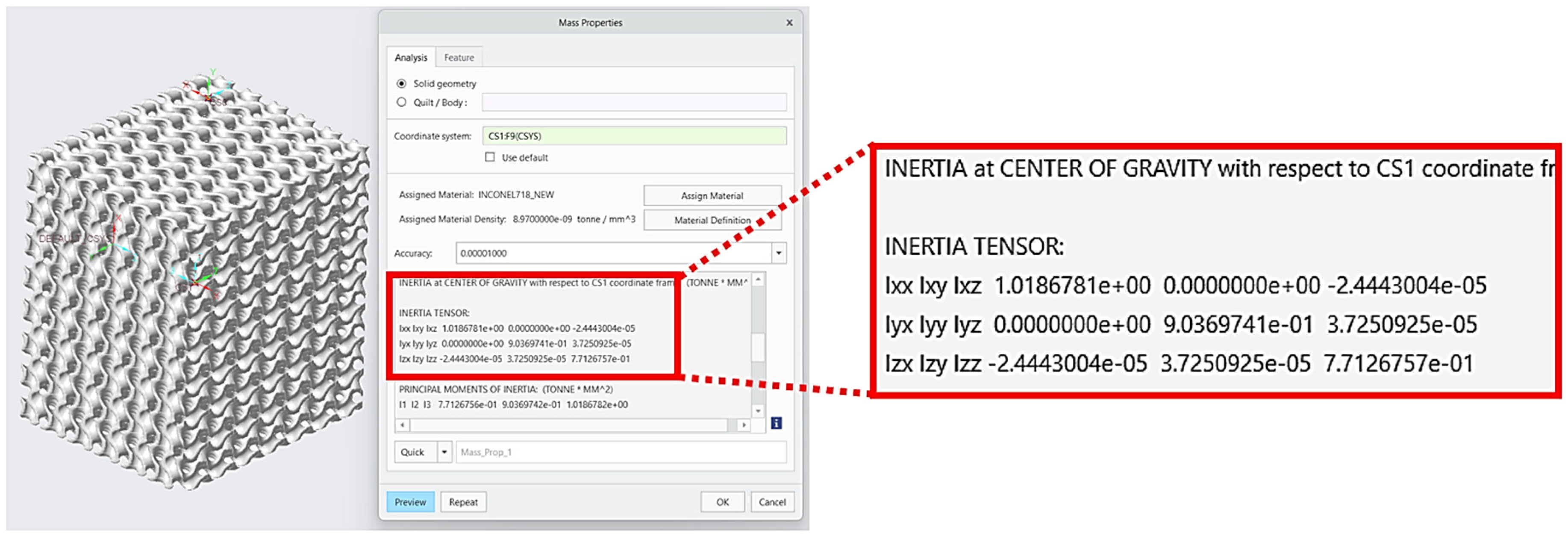
| Description | Value |
|---|---|
| Young’s modulus (MPa) | 1.65 × 105 |
| Poisson’s ratio | 0.3 |
| Bulk modulus (MPa) | 1.375 × 105 |
| Shear modulus (MPa) | 63,462 |
| Density (kg/m3) | 8220 |
| Ambient temperature (°C) | 21 |
| Natural Frequency | Type | FEA (Hz) | Experiment (Hz) | Relative Error (%) |
|---|---|---|---|---|
| No. 1 | 1st torsional about Z axis | 11,078 | 11,801 | 6.53 |
| No. 2 | 1st bending in XZ plane | 13,523 | 14,193 | 4.95 |
| No. 3 | 1st bending in YZ plane | 14,562 | 15,138 | 3.96 |
| No. 4 | 1st torsional about X axis | 15,151 | 15,979 | 5.46 |
Disclaimer/Publisher’s Note: The statements, opinions and data contained in all publications are solely those of the individual author(s) and contributor(s) and not of MDPI and/or the editor(s). MDPI and/or the editor(s) disclaim responsibility for any injury to people or property resulting from any ideas, methods, instructions or products referred to in the content. |
© 2024 by the authors. Licensee MDPI, Basel, Switzerland. This article is an open access article distributed under the terms and conditions of the Creative Commons Attribution (CC BY) license (https://creativecommons.org/licenses/by/4.0/).
Share and Cite
Monkova, K.; Braut, S.; Monka, P.P.; Skoblar, A.; Pollák, M. Numerical and Experimental Modal Analysis of a Gyroid Inconel 718 Structure for Stiffness Specification in the Design of Load-Bearing Components. Materials 2024, 17, 3595. https://doi.org/10.3390/ma17143595
Monkova K, Braut S, Monka PP, Skoblar A, Pollák M. Numerical and Experimental Modal Analysis of a Gyroid Inconel 718 Structure for Stiffness Specification in the Design of Load-Bearing Components. Materials. 2024; 17(14):3595. https://doi.org/10.3390/ma17143595
Chicago/Turabian StyleMonkova, Katarina, Sanjin Braut, Peter Pavol Monka, Ante Skoblar, and Martin Pollák. 2024. "Numerical and Experimental Modal Analysis of a Gyroid Inconel 718 Structure for Stiffness Specification in the Design of Load-Bearing Components" Materials 17, no. 14: 3595. https://doi.org/10.3390/ma17143595








